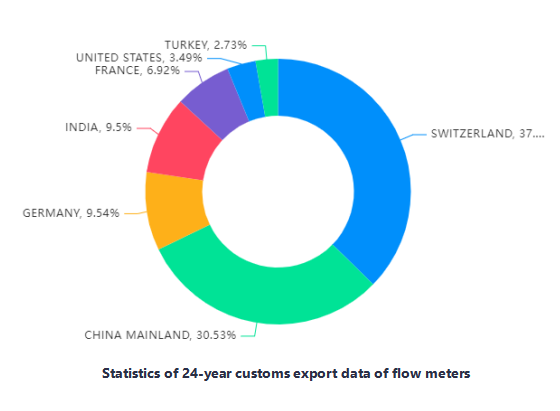Flowmeters are essential in various industries, helping measure and manage the flow of liquids, gases, and steam. Among the different types of flowmeters available, the vortex flowmeter holds a significant place due to its versatility and accuracy. Understanding the evolution and future prospects of the vortex flowmeter industry provides valuable insights into the broader flow measurement landscape.
Historical Context and Evolution
The history of flowmeters in my country, China, reveals a trajectory of significant transformation and advancements. Initially, the work on modern flow measurement technology began relatively late compared to other industrialized nations. In the early stages, the flowmeters required for industrial applications were predominantly imported from abroad, owing to a nascent domestic manufacturing landscape.
The early products within China’s flowmeter industry were traditional mechanical meters. These meters relied on straightforward mechanical devices to measure flow, and readings were typically taken manually. While foundational, these traditional flowmeters were limited in terms of accuracy and operational efficiency, necessitating further advancements.
Decades of development in the instrument manufacturing industry led to remarkable progress. The production level of instruments improved substantially, and the quality and functions of flowmeters were continually enhanced. This period saw a gradual shift from mechanical meters to more sophisticated electronic flowmeters, including the vortex flowmeter.
The Vortex Flowmeter: An Overview
The vortex flowmeter operates on the principle of vortex shedding, where vortices are generated and shed from a bluff body placed in the flow stream. As the fluid flows past the bluff body, it creates alternating low-pressure vortices on either side, which are detected and counted by the sensor. This count is then converted into a flow rate measurement. The accuracy and direct nature of this measurement technique make vortex flowmeters highly reliable and preferred for a wide range of applications, including steam, gas, and liquid flow measurement.
Technological Advancements and Industry Growth
Technological innovations have been integral to the evolution of vortex flowmeters. Continuous research and development have led to improvements in sensor design, signal processing, and overall instrument reliability. Modern vortex flowmeters feature enhancements such as digital signal processing, improved materials for the bluff body, and advanced calibration techniques. These improvements contribute to higher accuracy, better repeatability, and expanded operational ranges.
Significantly, the reform and opening up of China catalyzed the establishment and growth of the flowmeter manufacturing industry domestically. Japan, South Korea, and Taiwan in the Asia-Pacific region relocated parts of their manufacturing operations to mainland China. Furthermore, numerous multinational companies set up factories in China, leveraging the local manufacturing expertise and cost efficiencies.
These developments led to an increase in domestic production and consumption of flowmeters. China quickly became a pivotal market for global flowmeter consumption, with the output of instruments witnessing a marked rise. The number of instrument companies in China now ranks highest globally, underscoring the country’s prominence in the industry.

Future Development Directions
The future of the vortex flowmeter industry is poised for further growth and innovation. Several factors are likely to shape its development:
1. Technological Innovation: Continued advancements in sensor technology and digital signal processing will enhance the performance of vortex flowmeters. Focus on reducing manufacturing costs while improving reliability, stability, and consistency will drive further innovation. Integration of IoT and AI technologies could facilitate smart flowmeters capable of real-time data analysis and predictive maintenance.
2. Expansion of Application Fields: As industrial processes become more complex, the need for precise flow measurement across various fields, such as chemical processing, oil and gas, water treatment, and HVAC, continues to expand. Vortex flowmeters, with their versatility, are well-positioned to meet this growing demand.
3. Sustainability and Efficiency: Industries are increasingly focusing on sustainable practices and energy efficiency. Vortex flowmeters, with their ability to accurately measure and monitor fluid flow, contribute to optimized process control, reduced waste, and energy conservation. Future developments will likely emphasize eco-friendly materials and designs.
4. Domestic Market Growth: The domestic demand for high-quality flowmeters is set to rise as China continues to advance its industrial capabilities. Government policies encouraging technological innovation and industrialization of sensor and intelligent instrument design will support this growth. Increased investment in manufacturing technologies and special equipment development will further bolster domestic production.
5. Global Market Integration: China’s instrument manufacturing industry will continue to integrate with global markets. Exports of high-quality vortex flowmeters to international markets will increase, leveraging China’s manufacturing prowess and competitive pricing. Collaboration with international companies on research and development projects will foster innovation and growth.
Conclusion
The vortex flowmeter industry has witnessed considerable evolution from its early days of mechanical meters to sophisticated modern instruments. China’s journey from importing flowmeters to becoming a global manufacturing hub highlights the dynamic nature of this industry. With ongoing technological advancements, expanding application fields, and a focus on sustainability and efficiency, the future of vortex flowmeters holds immense potential. As China continues to lead in instrument manufacturing, the vortex flowmeter industry is set for an exciting trajectory of growth and innovation.
Post time: 2月-19-2025





